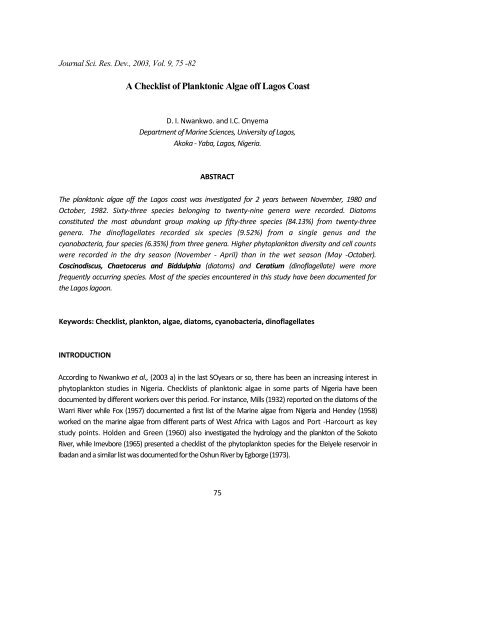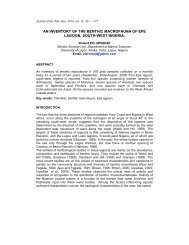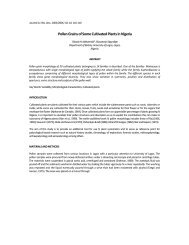A Checklist of Planktonic Algae off Lagos Coast - Jsrd.org
A Checklist of Planktonic Algae off Lagos Coast - Jsrd.org
A Checklist of Planktonic Algae off Lagos Coast - Jsrd.org
Create successful ePaper yourself
Turn your PDF publications into a flip-book with our unique Google optimized e-Paper software.
Journal Sci. Res. Dev., 2003, Vol. 9, 75 -82<br />
A <strong>Checklist</strong> <strong>of</strong> <strong>Planktonic</strong> <strong>Algae</strong> <strong>of</strong>f <strong>Lagos</strong> <strong>Coast</strong><br />
D. I. Nwankwo. and I.C. Onyema<br />
Department <strong>of</strong> Marine Sciences, University <strong>of</strong> <strong>Lagos</strong>,<br />
Akoka ‐ Yaba, <strong>Lagos</strong>, Nigeria.<br />
ABSTRACT<br />
The planktonic algae <strong>of</strong>f the <strong>Lagos</strong> coast was investigated for 2 years between November, 1980 and<br />
October, 1982. Sixty‐three species belonging to twenty‐nine genera were recorded. Diatoms<br />
constituted the most abundant group making up fifty‐three species (84.13%) from twenty‐three<br />
genera. The din<strong>of</strong>lagellates recorded six species (9.52%) from a single genus and the<br />
cyanobacteria, four species (6.35%) from three genera. Higher phytoplankton diversity and cell counts<br />
were recorded in the dry season (November ‐ April) than in the wet season (May ‐October).<br />
Coscinodiscus, Chaetocerus and Biddulphia (diatoms) and Ceratium (din<strong>of</strong>lagellate) were more<br />
frequently occurring species. Most <strong>of</strong> the species encountered in this study have been documented for<br />
the <strong>Lagos</strong> lagoon.<br />
Keywords: <strong>Checklist</strong>, plankton, algae, diatoms, cyanobacteria, din<strong>of</strong>lagellates<br />
INTRODUCTION<br />
According to Nwankwo et al., (2003 a) in the last SOyears or so, there has been an increasing interest in<br />
phytoplankton studies in Nigeria. <strong>Checklist</strong>s <strong>of</strong> planktonic algae in some parts <strong>of</strong> Nigeria have been<br />
documented by different workers over this period. For instance, Mills (1932) reported on the diatoms <strong>of</strong> the<br />
Warri River while Fox (1957) documented a first list <strong>of</strong> the Marine algae from Nigeria and Hendey (1958)<br />
worked on the marine algae from different parts <strong>of</strong> West Africa with <strong>Lagos</strong> and Port ‐Harcourt as key<br />
study points. Holden and Green (1960) also investigated the hydrology and the plankton <strong>of</strong> the Sokoto<br />
River, while Imevbore (1965) presented a checklist <strong>of</strong> the phytoplankton species for the Eleiyele reservoir in<br />
Ibadan and a similar list was documented for the Oshun River by Egb<strong>org</strong>e (1973).<br />
75
76 D. I. Nwankwo. and I. C. Onyema<br />
More recently Nwadiaro and Ezefili (1986) listed the phytoplankton <strong>of</strong> New Calabar River while Opute<br />
(1991) presented a checklist <strong>of</strong> the phytoplankton flora <strong>of</strong> the Warri / Forcados estuary. Nwankwo<br />
(1988a) has also presented a checklist <strong>of</strong> the Nigerian marine macroalgae from Tarkwa bay West mole<br />
whereas Nwankwo (1988b) complied a list <strong>of</strong> the planktonic algae <strong>of</strong> the <strong>Lagos</strong> Lagoon.<br />
Additionally, a checklist <strong>of</strong> algae in the plankton from the Bonny River have received attention by Chindah<br />
and Pudo (1991) and Kadiri (1999) also presented a list and distribution <strong>of</strong> phytoplankton in some coastal<br />
waters <strong>of</strong> Nigeria with <strong>Lagos</strong>, Ondo, Delta, Bayelsa and Rivers states as key sampling points for the<br />
survey. Further to this, Nwankwo et al., (2003a) also published an additional list to the already<br />
existing checklist for the <strong>Lagos</strong> Lagoon (Nwankwo, 1988b) after ISyears <strong>of</strong> additional phycological<br />
investigations in the region.<br />
Presently there is no published work on a checklist <strong>of</strong> phytoplankton species found in the sea <strong>of</strong>f the<br />
<strong>Lagos</strong> coast. The knowledge <strong>of</strong> these species and their role as foundational aquatic food chain <strong>org</strong>anism<br />
in the marine ecosystem particularly in the neritic waters <strong>of</strong>f <strong>Lagos</strong> cannot be understated. The<br />
aim <strong>of</strong> this project was to investigate the phytoplankton assemblage <strong>of</strong> the <strong>Lagos</strong> coast and hence<br />
document a checklist <strong>of</strong> encountered species.<br />
DESCRIPTION OF STUDY AREA<br />
The coastline <strong>of</strong> Nigeria boarders 853km <strong>of</strong> the Atlantic Ocean and is interrupted by a series <strong>of</strong><br />
estuarine entries to the sea. The coastal area <strong>of</strong> South‐western Nigeria, more specifically, is a<br />
meandering network <strong>of</strong> lagoons that angle approximately 45° to the prevailing south‐westerlies wind<br />
and parallel to the coastline (Hill and Webb, 1958; Webb, 1958; Ibe, 1988; Nwankwo, 2004b) (Figure<br />
1). Rainfall in this area though concentrated in one season is bimodal with peaks in June and<br />
September/October. This area is influenced by the semi‐diurnal tidal regime experienced along<br />
the entire West African coastal region (Webb, 1958; FAO, 1969; Olaniyan, 1969).<br />
The dominant ocean currents operating within the area include the Benguella, Guinea, Equatorial, and<br />
the Equatorial counter currents. High energy waves are generated within this region that<br />
continually pound the <strong>Lagos</strong> shoreline at an angle.
A <strong>Checklist</strong> <strong>of</strong><strong>Planktonic</strong> <strong>Algae</strong> <strong>of</strong>f <strong>Lagos</strong> <strong>Coast</strong><br />
MATERIALS AND METHODS<br />
Phytoplankton sample collection<br />
Phytoplankton samples for the two years <strong>of</strong> study were collected with the aid <strong>of</strong> a 55/j.m standard<br />
plankton net and the training vessel, 'Federal Argonaut'. The vessel is about 200m long and has an<br />
engine capacity <strong>of</strong> 425 hp and collections were made between latitudes 3°27'E and 3° 29'S and longitudes<br />
6° 17' Nand 16° 24^N for the study. On each occasion the net was tied to the vessel and towed at low<br />
speed (< 4knots) for Smins. All samples were collected in 250ml plastic containers with screw caps and<br />
preserved in 4% unbuffered formalin prior to biological analysis.<br />
Figure 1: Hydrological map <strong>of</strong> <strong>Lagos</strong> showing study area<br />
Phytoplankton analysis<br />
In the laboratory one drop, five different times for each sample after concentration to lOmls were<br />
investigated at different magnification (X15, X100 and X400) using a Zeiss binocular microscope with a<br />
calibrated eye piece. The microtransect drop count method described by Lackey (1938) and employed by<br />
Nwankwo (1984) was used. Since each drop is O.lml, results on abundance were multiplied by 10 to<br />
give the values as numbers <strong>of</strong> <strong>org</strong>anisms per ml. Appropriate texts were used to aid identification<br />
(Subramanyan, 1946; Smith, 1950; Hendey, 1958,1964; Desikachary, 1959; Foged, 1966; Wimpenny,<br />
1966; Patrick and Reimer, 1966, 1975; Nwankwo, 1990, 2004a). To<br />
77
78 D. I. Nwankwo. andl.C. Onyema<br />
enhance diatom identification, sub‐samples <strong>of</strong> the original samples were acid cleaned using a<br />
mixture <strong>of</strong> H2SO4 and HNO3 acids.<br />
RESULTS<br />
For the two year survey a total <strong>of</strong> sixty‐six species <strong>of</strong> phytoplankton were recorded. The diatoms were<br />
the most prominent group with a total <strong>of</strong> fifty‐three species (84.15%) from twenty‐three genera.<br />
Frequently occurring genera include Coscinodiscus (12 taxa), Chaetocerus (8 taxa), Biddulphia (6<br />
taxa) and Grammatophora (3 taxa). The din<strong>of</strong>lagellate were the second more prominent group<br />
with a total <strong>of</strong> six species (9.52%) from a sole genus (Ceratium). The cyanobactena recorded four<br />
species (6.35%) from three genera. Oscillatoria, Phormidium and Trichodesmium were the genera<br />
encountered.<br />
Table 1: A <strong>Checklist</strong> <strong>of</strong>planktonic algae <strong>of</strong>f the coast <strong>of</strong> <strong>Lagos</strong>.<br />
Bacillariophyceae<br />
Actinophycus splendens (Schadbolt) Ralfs<br />
Asterionella gracialis Cleve & Muller Bacillaria<br />
paxillifer (O. F. Muller) Hendey Biddulphia<br />
aurita (Lyngbe) Brebission Biddulphia<br />
longricruris Greville Biddulphia mobilense<br />
(Bailey) Grunow Biddulphia regia Schultze<br />
Biddulphia rhombus (Ehrenberg) Wm Smith<br />
Biddulphia sinensis Greville Cerataulina<br />
bergoni (Cleve) Hendey Chaetoceros<br />
atlanticum Cleve Chaetoceros coarctatum<br />
Lauder Chaetoceros decipens Cleve<br />
Chaetoceros densum Cleve Chaetoceros<br />
didymus Ehrenberg Chaetoceros diversum<br />
Cleve Chaetoceros laciniosum Shurt<br />
Chaetoceros peruvianum Brightwelli<br />
Corethron criphilum Castracane Coscinodiscus<br />
asteromphalus Ehrenberg Coscinodiscus<br />
centralis Ehrenberg Coscinodiscus eccentricus<br />
Ehrenberg
A <strong>Checklist</strong> <strong>of</strong> <strong>Planktonic</strong> <strong>Algae</strong> <strong>of</strong>f <strong>Lagos</strong> <strong>Coast</strong><br />
Coscinodiscus gigas Ehrenberg Coscinodiscus<br />
granni Gough Coscinodiscus janischii A. Schmidt<br />
Coscinodiscus jonesianus (Greville) Ostenfeld<br />
Coscinodiscus lineatus Ehrenberg Coscinodiscus<br />
marginatus Ehrenberg Coscinodiscus oculus‐<br />
iridis Ehrenberg Coscinodiscus radiatus<br />
Ehrenberg Coscinodiscus stellaris Ehrenberg<br />
Detonula schroderi P. Bergon Ditylum<br />
brightwelli (West) Grunow Donkinia sp<br />
Eucampia cornuta Ehrenberg Grammatophora<br />
marina (Lyngbye) Kutzing Grammatophora<br />
sourieri Amosse Grammatophora sp<br />
Gyrosigma wansbeckii (Donkin) Cleve<br />
Hyalodiscus stelliger Bailey Hyalodiscus sp<br />
Hemidiscus harmannianus (Greville) Mann<br />
Thallassionema longissima (Grunow)<br />
Cyanophyceae<br />
Oscillatoria margatifera (Kutzing) Gomont<br />
Oscillatoria nigro‐viridis Thwaites Phormidium<br />
fragile (Meneghini) Gomont Trichodesmium<br />
thiebautii Gomont<br />
Dinophyceae<br />
Ceratium furca Ehrenberg Ceratium<br />
fusus Ehrenberg Ceratium<br />
macroceros Ehrenberg Ceratium<br />
massilense Ehrenberg Ceratium<br />
pulchellum K<strong>of</strong>oid Ceratium tripos<br />
(O.F.M.) Nitzsch<br />
79
80 D. I. Nwankwo. andl.C. Onyema<br />
DISCUSSION<br />
From the study there were comparatively fewer numbers <strong>of</strong> species for this study viz a viz other<br />
seasonal microalgal investigations in the coastal waters <strong>of</strong> Nigeria (Nwankwo, 1988b; Nwankwo et al.,<br />
2003, Onyema et al., 2003). Comparatively, higher abundance and diversity <strong>of</strong> planktonic algal species<br />
was recorded for the dry season (November ‐ April) than in the wet season (May ‐October). For<br />
instance species <strong>of</strong>Coscinodiscus, Chaetocerus, Biddulphia, Ditylum and Ceratium occurred more<br />
frequently in the dry season. A good number <strong>of</strong> the species encountered for this study have been<br />
recorded in marine situations elsewhere (Subramanyan, 1946, Newell and Newell, 1966; Wimmpenny,<br />
1966).<br />
Furthermore, the occurrence <strong>of</strong> din<strong>of</strong>lagellates species such as Ceratium furca, Ceratium fusus,<br />
Ceratium tripos and diatoms such as Chaetoceros convolutus, Cerataulina bergonii and<br />
Coscinodiscus centralis among other diatoms have also been reported to impose anoxia, clogging and<br />
damage <strong>of</strong> fish gills under bloom conditions in the same region (Nwankwo et al., 2003 a,b).<br />
The occurrence <strong>of</strong> the cyanobacteria Trichodesmium thiebautii was observed only in warm,<br />
stratified, relatively nutrient poor waters in the dry season. Nwankwo et al., (2003b) have reported that<br />
Trichodesmium thiebautii blooms in the coastal waters <strong>of</strong> south‐western Nigeria and clogging <strong>of</strong> fishing<br />
nets in bloom conditions have also been reported in the same region for this cyanobacterium<br />
Species <strong>of</strong> Oscillatoria and Phormidium encountered during the study are likely immigrant forms from<br />
land brought in with floodwaters during the rains.<br />
REFERENCES.<br />
Chinda, A.C and Pudo, J. (1991). "A preliminary checklist <strong>of</strong> algae found in plankton <strong>of</strong> Bonny<br />
River in Niger Delta, Nigeria". Fragmflor. Geobot.36 (1): 112‐126.<br />
Desikachary, T.V. (1959). Cyanophyta. Indian Council <strong>of</strong> Agric. Research, New Delhi. 686pp. Egb<strong>org</strong>e,<br />
A.M.B. (1973). "A preliminary check list <strong>of</strong> the phytoplankton <strong>of</strong> the Oshun river,<br />
Nigeria". Freshwater Biol. 4: 177 ‐ 191. Foged, N. (1966). "Freshwater diatoms from Ghana".<br />
Biologiske Skrifter Det Kongelige Dansfe<br />
Videnskabernes Selskab. 15(1). 160pp F.A.O. (1969). Fisheries Survey in the Western and Mid‐<br />
Western Regions <strong>of</strong> Nigeria. FAO/Sf:<br />
74/NIR 6. 142pp. Fox, M. (1957). "A first list <strong>of</strong> marine algae from Nigeria". Jour. Linn. Soc.<br />
London. LV (365):<br />
615‐631. Hendey, N.I. (1958). "Marine diatoms from West African Ports". Journal <strong>of</strong> Royal<br />
Microscopic,<br />
Society. 77: 28‐88.
A <strong>Checklist</strong> <strong>of</strong><strong>Planktonic</strong> <strong>Algae</strong> <strong>of</strong>f <strong>Lagos</strong> <strong>Coast</strong><br />
Hendey, N.I. (1964). An introductory account <strong>of</strong> the smaller algae <strong>of</strong> British coastal waters. Part<br />
5. Bacillariophyceae (diatoms) London. N.M.S.O. 317pp. Hill, M.B. and Webb, J.E. (1958). "The ecology<br />
<strong>of</strong> <strong>Lagos</strong> lagoon II. The topography and physical<br />
features <strong>of</strong> the <strong>Lagos</strong> harbour and <strong>Lagos</strong> lagoon". Philosophical Transaction <strong>of</strong> Royal<br />
Society, London. 241:307‐417. Holden, M.J. and Green, J. (1960). "The hydrology and plankton <strong>of</strong> River<br />
Sokoto". J. anim. Ecol.<br />
29: 65 ‐ 84.<br />
Ibe, A. C. (1988). <strong>Coast</strong>line erosion in Nigeria. University Press, Ibadan. 217pp. Imevbore, A.M.A. (1965). "A<br />
preliminary checklist <strong>of</strong> the planktonic <strong>org</strong>anism <strong>of</strong> the Eleiyele<br />
Reservoir, Ibadan, Nigeria". Journal <strong>of</strong> West Africa Science Association. 10: 156 ‐ 160. Kadiri, M.O.<br />
(1999). "Phytoplankton distribution in some coastal waters <strong>of</strong> Nigeria". Nigeria<br />
Journal <strong>of</strong> 'Botany.12 (1): 51 ‐ 62. Lackey, J.B. (1938). The manipulation and counting <strong>of</strong><br />
river plankton and changes in some<br />
<strong>org</strong>anism due to formalin preservation. U.S. Public Health Reports. 63, 2080‐2093. Mills, F.W. (1932).<br />
"Some diatoms from Warri, Southern Nigeria". J.R.Micro. Soc., 52:383 ‐ 394. Newell, G.E and Newell, R.C.<br />
(1966). Marine plankton: a practical guide. Revised Edition.<br />
Hutchinson London. 225pp. Nwadiaro, C.S. and Ezefili, E.O. (1986). "A preliminary checklist <strong>of</strong> the<br />
phytoplankton <strong>of</strong> New<br />
Calabar river, lower Niger delta, Nigeria". Hydrobiol. Bull. 19: 133 ‐ 138 Nwankwo D. I. (1984).<br />
"Seasonal Variation <strong>of</strong> Phytoplankton <strong>of</strong> <strong>Lagos</strong> Lagoon and the Adjacent<br />
Sea inRelation to EnvironmentalFactors"..P/i.,D77zesi's, University <strong>of</strong> <strong>Lagos</strong>, Akoka. 447pp. Nwankwo, D.<br />
I. (1988a). "A <strong>Checklist</strong> <strong>of</strong> Nigerian Marine <strong>Algae</strong> (Tarkwa Bay)". Nigerian<br />
Journal <strong>of</strong> Botany 1: 47‐50. Nwankwo, D.I. (1988b). "A preliminary checklist <strong>of</strong> planktonic algae in<br />
<strong>Lagos</strong> lagoon Nigeria".<br />
Nigerian Journal <strong>of</strong>Botanica I Applied Sciences.. 2: 73‐85. Nwankwo, D.I. (1990). "Contribution to the<br />
Diatom flora <strong>of</strong> Nigeria. Diatoms <strong>of</strong> <strong>Lagos</strong> lagoon<br />
and the adjacent sea". Nig. J. Bot. 3: 53‐70. Nwankwo, D.I. (2004a). The Microalgae: Our<br />
indispensable allies in aquatic monitoring and<br />
biodiversity sustainability. University <strong>of</strong> <strong>Lagos</strong> Press. Inaugural lecture series. 44pp. Nwankwo, D.I.<br />
(2004b). A Practical Guide to the Study <strong>of</strong> <strong>Algae</strong>. JAS Publishers, <strong>Lagos</strong>. Nigeria. Nwankwo, D.I; Onyema, I.C.;<br />
Adesalu, T.A.; Olabode, R.J.;Osiegbu, G.O. and Owoseni,<br />
T.I. ( 2003a). "Additions to a preliminary check‐list <strong>of</strong> planktonic algae in <strong>Lagos</strong> lagoon,<br />
Nigeria". Journal <strong>of</strong> Science Technology and Environmental. 3(1). 8‐12. Nwankwo, D.I., Onyema, I.C.<br />
and Adesalu, T.A.(2003b). " survey <strong>of</strong> harmful algae in coastal<br />
waters <strong>of</strong> south‐western Nigeria". Journal <strong>of</strong> Nigerian Environmental Society. 1(2): 241 ‐<br />
246. Olaniyan, C.I.O. (1969). "The seasonal variation in the hydrology and total plankton <strong>of</strong> the<br />
lagoons <strong>of</strong> South West, Nigeria". Nigerian Journal <strong>of</strong> Science. 3(2): 101‐119.<br />
81
82<br />
D. I. Nwankwo. and I. C. Onyema<br />
Onyema, I.C., Otudeko, O.G. and Nwankwo, D.I. (2003). "The distribution and composition <strong>of</strong><br />
plankton around a sewage disposal site at Iddo, Nigeria". Journal <strong>of</strong> Scientific Research<br />
Development..7: 11‐24. Opute, F.I. (1991). "A checklist <strong>of</strong> the freshwater, brackish andmarine<br />
phytoplankton <strong>of</strong> the Warn<br />
/Forcados estuaries <strong>of</strong> southern Nigeria". Nig. J. Bot. 4: 227 ‐ 254. Patrick, R. and Reimer, C.W.<br />
(1966). "The diatoms <strong>of</strong> the United States exclusive <strong>of</strong> Alaska and<br />
Hawaii (Vol. 1)". Monogr. Acad. Nat. Sci. Philadelphia. 686pp. Patrick, R. and Reimer, C.W.<br />
(1975). "The diatoms <strong>of</strong> the United States exclusive <strong>of</strong> Alaska and<br />
Hawaii (Vol. 2, part 1)". Monogr. Acad. Nat. Sci. Philadelphia. 213pp. Smith, G.M. (1950). The<br />
fresh‐water algae <strong>of</strong> the United States. McGraw‐Hill, London.719pp. Subrahmanyan, R.(1946). "A<br />
systematic account <strong>of</strong> the marine plankton diatoms <strong>of</strong> the Madras<br />
coast". Proceedings <strong>of</strong> the Indian Academy <strong>of</strong> Science. 24: 85 ‐ 197. Vanlandingham, S.L. (1982).<br />
"Guide to the identification and environmental requirements and<br />
pollution tolerance <strong>of</strong> freshwater blue‐green algae (cyanophyta)". U.S. Environmental<br />
Protection Agency, EPA ‐ 60. Webb, J.E. (1958). "The Ecology <strong>of</strong> <strong>Lagos</strong> lagoon. 1: The<br />
lagoons <strong>of</strong> the Guinea <strong>Coast</strong>".<br />
Philosophical Transaction Royal Society London. Ser B: 241‐283. Wimpenny, R.S. (1966). The<br />
plankton <strong>of</strong> the sea. Faber and Faber Limited, London. 426pp.




